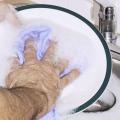Quality Measure 3: All About Water Temperature
 One of the most frequently cited Title 22 regulations is 87303, Maintenance & Operation. Between March 2013 and August 2018, 10% of the citations issued to San Diego’s licensed RCFEs by California’s Department of Social Services, Community Care Licensing Division (DDS/CCLD) were for deficiencies in 87303, with non-compliant water temperature among the top reasons for DSS/CCLD issuing the citation.
One of the most frequently cited Title 22 regulations is 87303, Maintenance & Operation. Between March 2013 and August 2018, 10% of the citations issued to San Diego’s licensed RCFEs by California’s Department of Social Services, Community Care Licensing Division (DDS/CCLD) were for deficiencies in 87303, with non-compliant water temperature among the top reasons for DSS/CCLD issuing the citation.
According to 87303(e)(2), an RCFE shall maintain the temperature of water used by residents within the range of 105 degrees (F) and 120 degrees (F). This article shares information on facility water temperature as it relates to compliance and resident safety and comfort.
Staying in compliance
In a facility, hot water has many uses – showering, hand-washing, laundry, dish washing, to name a few.
Water temperatures set too high may result in physical harm (scalding) to residents and staff, but set too low may result in not getting enough hot water to the task or an increased risk of growing bacteria (Legionella) inside the water heater. The EPA recommends maintaining final water temperature at 120 degrees and reminds users that 140 and 150 degrees can result in 3rddegree burns in just a few seconds. However, to achieve 120 degrees at the point of use may mean setting the working temperature (or water heater temperature) to more than 150 degrees since different water heating systems have different sizes, location and other influencing factors.
One solution, offered by the plumbing industry, to achieve safe and consistent water temperature is the use of hot water tank boosters. Hot water tank boosters keep water at 140 degrees in the tank, but mixes heated water with cold water once it leaves the tank to lower the temperature to 120 degrees before it reaches the tap. This technology can be compared to traditional batch heating (where heat is applied directly to water stored in a holding tank) or on-demand heating/tankless water heaters (where cold water runs through a heat source en-route to its final destination). Here is a helpful link to better understand how a tank booster works (The inclusion of this link is in no way an endorsement of this product or company.)
Keeping your residents comfortable
While the body temperature of older adults does not change with age, controlling body temperature does. With advanced ages, skin becomes thinner and fat underneath the skin diminishes, reducing our ability to insulate ourselves. In addition, the ability to maintain a core body temperature and to detect and respond to changes in temperature decreases with age due to changes in organ function, metabolism, lost muscle mass, or as a side effect of some medications.
Because of these changes, it is important facilities be attentive to areas of resident care where temperature control may be an issue. Water temperature during showering is one of these situations.
A good rule of thumb is to set bathwater a few degrees above body temperature to start. However, there is no ideal water temperature; ideal temperature should be decided based on personal preference. Caregivers should remain mindful of residents’ reduced ability to regulate their body temperature and respond to changes in temperature; they should inquire about comfort level often.
Other ways to keep your resident comfortable
If a caregiver sees shivering during showering, this means that the resident’s core body temperature is being affected. Shivering is a sign of our body’s natural drive to keep warm. Shivering is a preventable discomfort if the temperature of the water and bathing room are appropriate. Trying to keep the air and water temperature similar will help reduce any shock related to temperature changes and increase resident comfort. It is also important to keep in mind, warmer air in the bathroom may make cooler baths may seem warmer than they really are or if a bathroom is too cold, the water will always seem too cold.
Nutrition and hydration also play an important role in the regulation of body temperature. Prior to bath time, a high protein meal may help residents stay warmer. High protein meals increase our metabolic rate by 30% and help sustain it for much longer rather than a high carbohydrate meal which increases our metabolic rate by only 4% with this energy being used up more quickly. Cold foods can also be avoided prior to showering since cold foods may lower body temperature. Additionally, since older adults may lose their sense of thirst, encouraging hydration throughout the day may also reduce discomfort. Our core body temperature remains stable as long as fluid and salt are sufficient in the body.
Final Thoughts
Carefully monitoring your facility’s water temperatures at all points of use will not only keep you in compliance with Title 22 regulations, but will positively contribute to your residents’ health and safety. If you have tips for maintaining your water temperature at regulatory levels, and want to share, contact the Choose Well Program office – we'll pass those tips along to other Choose Well members.




